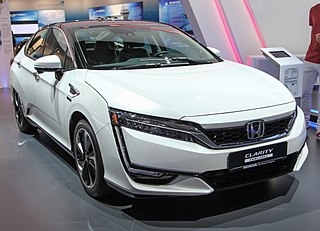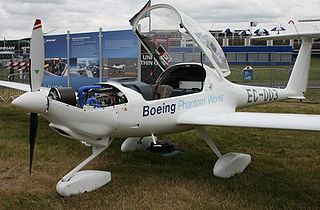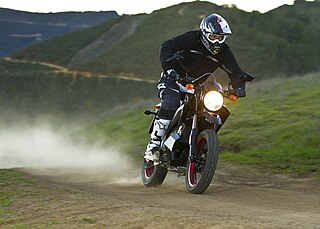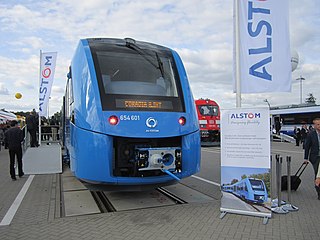Related Research Articles

A fuel cell is an electrochemical cell that converts the chemical energy of a fuel and an oxidizing agent into electricity through a pair of redox reactions. Fuel cells are different from most batteries in requiring a continuous source of fuel and oxygen to sustain the chemical reaction, whereas in a battery the chemical energy usually comes from metals and their ions or oxides that are commonly already present in the battery, except in flow batteries. Fuel cells can produce electricity continuously for as long as fuel and oxygen are supplied.

A hydrogen vehicle is a vehicle that uses hydrogen fuel for motive power. Hydrogen vehicles include hydrogen-fueled space rockets, as well as automobiles and other transportation vehicles. The power plants of such vehicles convert the chemical energy of hydrogen to mechanical energy either by burning hydrogen in an internal combustion engine, or, more commonly, by reacting hydrogen with oxygen in a fuel cell to run electric motors. Widespread use of hydrogen for fueling transportation is a key element of a proposed hydrogen economy.

A compressed-air vehicle (CAV) is a transport mechanism fueled by tanks of pressurized atmospheric gas and propelled by the release and expansion of the gas within a Pneumatic motor. CAV's have found application in torpedoes, locomotives used in digging tunnels, and early prototype submarines. Potential environmental advantages have generated public interest in CAV's as passenger cars, but they have not been competitive due to the low energy density of compressed air and inefficiency of the compression / expansion process.
The hydrogen economy is the use of hydrogen as a low carbon fuel, particularly for heating, hydrogen vehicles, seasonal energy storage and long distance transport of energy.
Hydrogen fuel is a zero-emission fuel burned with oxygen. It can be used in fuel cells or internal combustion engines. It has begun to be used in commercial fuel cell vehicles such as passenger cars, and has been used in fuel cell buses for many years. It is also used as a fuel for spacecraft propulsion.

A fuel cell vehicle (FCV) or fuel cell electric vehicle (FCEV) is a type of electric vehicle which uses a fuel cell, instead of a battery, or in combination with a battery or supercapacitor, to power its on-board electric motor. Fuel cells in vehicles generate electricity to power the motor, generally using oxygen from the air and compressed hydrogen. Most fuel cell vehicles are classified as zero-emissions vehicles that emit only water and heat. As compared with internal combustion vehicles, hydrogen vehicles centralize pollutants at the site of the hydrogen production, where hydrogen is typically derived from reformed natural gas. Transporting and storing hydrogen may also create pollutants.

The Honda Clarity is a nameplate used by Honda on alternative fuel vehicles. It was initially used only on hydrogen fuel-cell electric vehicles such as the 2008 Honda FCX Clarity, but in 2017 the nameplate was expanded to include the battery-electric Honda Clarity Electric and the plug-in hybrid electric Honda Clarity Plug-in Hybrid, in addition to the next generation Honda Clarity Fuel Cell.

A hydrogen-powered aircraft is an aeroplane that uses hydrogen fuel as a power source. Hydrogen can either be burned in a jet engine, or other kind of internal combustion engine, or can be used to power a fuel cell to generate electricity to power a propeller.
A water-fuelled car is an automobile that hypothetically derives its energy directly from water. Water-fuelled cars have been the subject of numerous international patents, newspaper and popular science magazine articles, local television news coverage, and websites. The claims for these devices have been found to be pseudoscience and some were found to be tied to investment frauds. These vehicles may be claimed to produce fuel from water on board with no other energy input, or may be a hybrid claiming to derive some of its energy from water in addition to a conventional source.

The BMW Hydrogen 7 is a limited production hydrogen internal combustion engine vehicle built from 2005-2007 by German automobile manufacturer BMW. The car is based on BMW’s traditional gasoline-powered BMW 7 Series (E65) line of vehicles, and more specifically the 760Li. It uses the same 6 litre V-12 motor as does the 760i and 760Li; however, it has been modified to also allow for the combustion of hydrogen as well as gasoline, making it a bivalent engine. Unlike many other current hydrogen powered vehicles like those being produced by Hyundai, Honda, General Motors, and Daimler AG - which use fuel cell technology and hydrogen to produce electricity to power the vehicle - the BMW Hydrogen 7 burns the hydrogen in an internal combustion engine.

Electric motorcycles and scooters are plug-in electric vehicles with two or three wheels. The electricity is stored on board in a rechargeable battery, which drives one or more electric motors. Electric scooters have a step-through frame.

An alternative fuel vehicle is a vehicle that runs on a fuel other than traditional petroleum fuels ; and also refers to any technology of powering an engine that does not involve solely petroleum. Because of a combination of factors, such as environmental concerns, high oil prices and the potential for peak oil, development of cleaner alternative fuels and advanced power systems for vehicles has become a high priority for many governments and vehicle manufacturers around the world.

The Toyota FCHV is a current hybrid hydrogen fuel cell vehicle development programme of the Toyota Motor Corporation, which was leased to a limited number of drivers in the United States and Japan beginning in 2002. "FCHV" stands for "Fuel Cell Hybrid Vehicle". A number of prototypes have been produced, up to the latest FCHV-adv ("advanced").
The Honda FCX is a family of hydrogen fuel cell automobiles manufactured by Honda.

Hydrail is the generic adjective term describing all forms of rail vehicles, large or small, which use on-board hydrogen fuel as a source of energy to power the traction motors, or the auxiliaries, or both. Hydrail vehicles convert the chemical energy of hydrogen to mechanical energy, either by burning hydrogen in a hydrogen internal combustion engine, or by reacting hydrogen with oxygen in a fuel cell to run electric motors. Widespread use of hydrogen for fueling rail transportation is a basic element of the proposed hydrogen economy. The term is used extensively by research scholars and technicians around the world.

The Riversimple Urban Car is a conceptual open source hydrogen fuel cell vehicle that was proposed by Hugo Spowers' company, Riversimple, in 2009. Their latest model, the Rasa, was unveiled on 17 February 2016.
ITM Power manufactures integrated hydrogen energy solutions to enhance the utilisation of renewable energy that would otherwise be wasted and specializes in electrolysers, and hydrogen for fuel cell products. On 22 February 2017 Royal Dutch Shell opened its first Hydrogen Refuelling station in the UK and the first in the UK to be sited on a forecourt. The station was supplied by ITM Power.

Intelligent Energy is a fuel cell engineering company focused on the development and commercialisation of its PEM fuel cell technologies for a range of markets including automotive, stationary power and UAVs. It is headquartered in the UK, with offices and representation in the US, Japan, Korea, and China.

The Toyota Mirai is a mid-size hydrogen fuel cell car manufactured by Toyota, one of the first such sedan-like vehicles to be sold commercially. The Mirai was unveiled at the November 2014 Los Angeles Auto Show. As of December 2017, global sales totalled 5,300 Mirais. The top-selling markets were the U.S. with 2,900 units, Japan with 2,100 and Europe with 200.
References
- ↑ "Fuel cell motorcycle". youtube.com. Retrieved 2006-10-11.
- ↑ "Intelligent Energy" . Retrieved 2007-04-02.
- ↑ "Fuel cell motorcycle". youtube.com. Retrieved 2006-10-11.